In this article, we will talk about how to properly transplant the indoor flower.
Content
They gave you indoor flowers or did you buy them yourself to please yourself? How lovely. Every day, the flower will delight the eyes with its appearance, as well as benefit, purifying air. But in order to enjoy his appearance, you need to properly care for him, water and, if necessary, transplant.
Spring is the best time for transplanting indoor colors. But there are some reasons when the transplant is necessary, and it does not matter what time of the year outside the window.
Reasons why you can not hesitate with a transplant of indoor flowers
- The pot is not suitable in size. The flower has grown and the root system is no longer enough space in it. It can be determined by the fact that the earth quickly dries from the drainage system, the holes at the bottom of the pot are visible the roots of the plant.
- The flower has an unhealthy look. The leaves fall or turn yellow quickly, the plant has a sluggish look.
- Sour soil.From abundant watering and poor drainage, the soil may deteriorate, this is evidenced by an unpleasant odor and the appearance of light brown plaque on the walls of the pot.
- The plant has not been transplanted for a long time.If the green pet has lost its former beauty, it has long been not pleasing to the owners with its flowering, it may mean that the Earth has exhausted its properties.

Flower transplant - New flower. The plant purchased in the store can be planted in the soil inappropriate for it, and peat is often used. Having brought home you need to study the soil and, if necessary, transplant.
- The indoor plant grew a pot. The flower has grown in a pot so that it already starts to just get out of it. For example, many children around appeared and there was little space for everyone.
There are also moments when you do not need to disturb the plant. If it blooms in the spring, you must definitely wait for the end of flowering and only then transplant.
Types of transplanting indoor flowers
Depending on how much land is replaced, such types of transplantation:
- Complete - The whole earth is replaced, the roots are completely cleansed of the old soil.
- Incomplete - Some of the soil remains on the roots of the plant.
- Replacement of the upper layer - This type of transplant is mainly used for large indoor plants. Loosen and remove up to five cm of the old substrate and fall asleep on top, compacting it.
Similar to transplant reception - pereging.It is used in the case when it is physically impossible to clean the roots completely or the plant was in one pot for a long time and a dense lump was formed with the crums. The main difference between the transplant from the transplant is that the soil in which the roots are located is not violated. In fact, the flower is simply transferred to a new large pot.

A characteristic feature is that the roots of the plant are not so injured. To carry out the transshipment correctly, it is necessary to clearly follow the rules of the procedure.
Try to gently extract the plant from the old pot. To do this, you need to flure the soil a little along the edges, and carefully remove the plant. To extract a large culture, you need to put the pot on the side, loosen the ground and easily remove the pot.
It is not necessary to free roots from the ground. Gently rearrange the flower into a new container so that it is in the center. After that, fill the free area of \u200b\u200bthe pot with a new nutrient substrate, slightly compact it and pour. It is important that the plant is firmly fixed in the soil. If this does not happen, it is better to choose a larger container or pour another layer of soil.
What is needed for transplanting indoor colors?
To engage in transplantation, you need to prepare a place and all the necessary materials. Choose a pot, prepare drainage and determine the soil.
Selection of pots.The choice is carried out depending on the size, it should be 3-5 cm more per old pot. You can not use the size much larger than the previous one, since the plant can stop in growth or die. For the proportional development of the bulk of indoor plants, very large containers are not required.
Planting containers are distributed into 3 types: pot, Kashpo and container.
- Pots, Unlike kashpo, they have one or more holes at the bottom designed to drain water. The drainage holes make it possible to moisturize the soil by pouring water into the pallet, so called lower watering. The pot is inserted into the pot.
- Container Most often, it also has no holes. Several pots are located in it or several plants are planted. Flower containers are most often made of clay or plastic. Those and others have their pros and cons.

- There are also pots with an automatic watering system. They have a special indicator, which indicates the amount of water in the pot. It makes it possible to reduce, watering to several times a year.
- Clay pots More by weight, it is more difficult to turn them over, but easy to break. Clay has a porous structure, and excess moisture evaporates quickly, but the pores can clog with salts often this is impossible to clean. They are also more expensive than plastic containers.
- Plastic pots Light and practically do not break when falling. They hold moisture well, plants can be watered less often, but with excess watering, it can lead to a fuel of roots and oxidation of the soil. The choice is significantly diverse and easier to care.
Selection of soil. For plants, special prepared mixtures are used, which are sold in stores. The variety is quite extensive and it is easy to choose the right mixture for your plant.
When buying a finished mixture, you need to focus on which plants it is intended for. So, the mixture for cacti contains more sand, the soil for orchids is lighter and loose, azalia requires a mixture with greater acidity. It is better to choose a substrate from trusted manufacturers.

If you have not found a mixture for a particular plant, you can choose another, but suitable for the same family. It is better to open the packaging before the transplant, since the nitrogen that gathered during the storage should evaporate, otherwise the roots of the plant may suffer.
It is not particularly desirable to use For planting and transplanting indoor colors, ordinary garden soil, as it may not be suitable in composition, and is also most often infected with parasites or pathogenic organisms, which at room temperature actively multiply and harm the plant.
How to transplant a room flower?
- You need to prepare a pot
Before transplanting a plant for permanent residence, it needs to be prepared. The new one can simply be disinfected by doused with boiling water, and the one that was already used to wash well with soap and then rinse thoroughly. If a plaque is observed inside the pot, then lemon water will help get rid of it: use 0.5 tsp. for 3 liters of water.

Leave the pot in this solution for 1.5 hours, and the plaque is easily washed. Leave the clay pot in the water for the whole night to get rid of the burned lime, which, when combined with water, forms harmful to the roots of the connection.
- Elimination of plants
The day before the upcoming transplantation of the indoor flower, it should be abundantly watered or lower the pot with the plant into a container of water so that the water reaches the edge of the pot, then it will be easy to extract from the old container. It is best to take out in this way: take a pot with one hand and overturn it into the palm of the other hand so that the stem of the plant is clamped between the fingers, and the pot is upside down. Carefully knock on the bottom and walls of the pot so that the lump of the earth goes outside.

Then you need to carefully clean the roots of the plant from the upper earth, trying not to damage them. Remove the rotten roots. If the roots are damaged, then sprinkle the cut with crushed coal. You can’t keep open roots in the air for a long time, because Small hairs can dry and the plant will be wagged.
- Make drainage
The pot should have holes, and on the bottom you need to place a layer of 1-2 cm from pebbles or small expanded clay. If you have no holes, then the drainage layer should be more than 3-4 cm.
- Landing
We fill the pot with earth and lower the plant onto the layer of the earth so that the root neck is just below the edges of the pot. Between the roots should not be left free space, so you need to compact the land. The root neck of the flower should be located at the same level with the ground, which, in turn, should be 1-2 cm below the edge of the pot.
Fill the gaps between the remaining old earthen lump and walls of the pot with a new moisturized substrate. The water temperature for moisturizing the soil should be a couple of degrees more than room. Ceramzitis needs to be poured onto the upper layer - it will protect the soil from mold, and will also give a more original appearance.

During the transplantation of indoor colors, it is not recommended to cut plants, since it will be difficult for them to recover after two stresses. And most importantly - the flowers are best transplanted during the period of the growing moon, then they will take root better, and they will transfer the "housewarming" painlessly.








